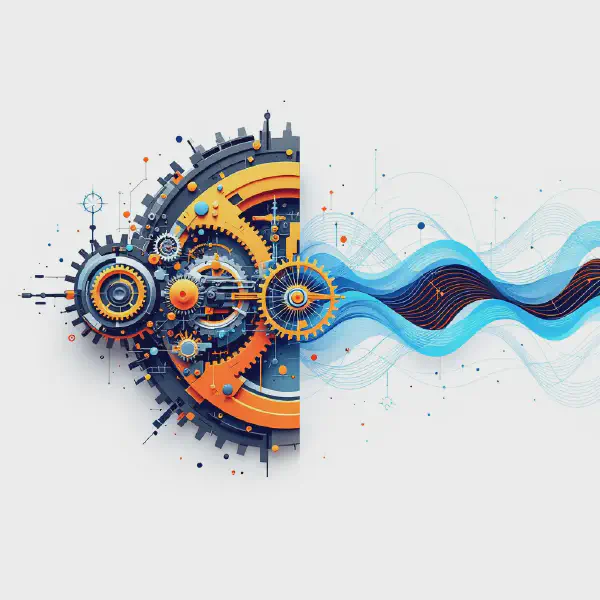Automating Brand Visuals: Solving Our Own Challenge

Automating Visuals
If your business creates content and does not have a dedicated designer on-staff, you know how painful the process of selecting images can be.
Start with a great idea to illustrate the concept, search image subscription services for the perfect photo or illustrations, don’t find anything that matches precisely, pick “good enough” option, look back at it few months down the road and cringe on how cliche it was.
We did pick a lot of cringe images despite spending hours looking for one. Robot handshakes, business people looking at paper, construction people looking at plans - generic imagery seen everywhere. Cliche that does not add anything to the content, takes time to find and does not present a cohesive brand image.
This was an excellent example of investing time and money for substandard results that bring little value.
Something had to be done. Hiring designer would be ideal but not in the plans yet, so being a technology company, we solved the problem with tech.
Solution Result
To our untrained designer eye the results look better. Plus the solution provided additional benefits:
- saved time - reduced from hours to under 15 seconds at a cost of around 6 cents per image
- achieved consistent look across all illustrations
- gave us ability to quickly change the intended brand voice and regenerate illustrations to match (it’s important to support change)
- kept full human-in-the-loop control
- provided cost efficiency when compared to the image subscription services
- future-proofed ability to quickly generate a prototype
- eliminated editing since images are generated in the requested format and ratio
The solution? AI Agent.
The Process: Starting with the voice and brand
One the problems we were trying to solve is providing visual consistency across all imagery. First step to achieving this was defining voice, design elements, artistic style and color scheme - with the help of designer.
Once few viable variants were defined, we started working on outlining the role of the AI. Do we want it to act as a designer? A marketer? A storyteller? Each role results in different outcomes so it’s an important business decision to figure out which point of view is more valuable.
Defining requirements
To be viable, the process needed to be as efficient as possible - and that meant automation. From detecting a new piece of content to reading and defining key concepts to creating an image are done by the AI Agent without any involvement from human.
However human must review and approve the result. Because we didn’t want to sit around waiting for process to finish, it was important to ensure that image is ready at most one minute after the content is complete.
Another guardrail was a budget given to the Agent. The monthly spend is tracked and human is notified at critical points so there are no surprises when the bill arrives.
We included a logging feature recording every Agent iteraction and human validation results to allow for reviewing and improving the process in the future.
Experimentation
We had many levers to play with in order to control the output:
- Style and color. We added and removed colors to preferred palette, tried specifying preference for gradients, provided strict instructions on background color. We also dialed in style (modern vs modern minimalist) and experimented with shapes (linear? architectural? organic?)
- AI Role. Corporate designer will produce different point of view from marketer. We landed on a marketing storyteller after much experimentation.
- Level of chaos and randomness - defined by a temperature parameter and ability for image generation to rehash the input.
- Choice of a specific AI model. We noticed that running a “better” model did not actually translate into better output. It was trying to be too clever ending in a proverbial deep forest - while smaller models tried to follow the instructions and just do a good job.
Comparing results
We ran multiple bench tests with various level variations to perfect the process. Because running the process twice with exactly same variables never produces the same result, it was important to define how to evaluate and compare the outputs.
We structured evaluation in two groups:
Step 1: Validating the Solution
Before spending time dialing in the accuracy and quality, we wanted to answer the fundamental question - is the proposed solution capable of solving our problem?
- Would this solution save time and money in comparison to the existing process?
- Is it easily scalable to accommodate more images (including costs - as scaling up the process may make it more expensive then original approach)
- Can it produce acceptable results that are better when compared with the current process?
Step 2: Fine-tuning the Process
Once we confirmed that proof of concept would work, we developed a score measuring the output across multiple criteria. To compare, we selected few test pieces of content and described what success would look like across each dimension.
Then we ran tests on the same content changing one variable at a time and using human grading to evaluate results and generate a score.
Grading by actual people is a gold standard. But of course it introduces a certain level of personal opinion. In our personal untrained designer opinion, the final selection of variables produced the best results - certainly better then what we had before.
But it would be important to admit that professional designer would be able to create even better outcomes.
This tool empowers non-specialists but it takes specialists to excel.
Project challenges
The challenges were typical for such projects: how to ensure structured response so that Agent can take the next step, how to reduce hallucinations and drifts, etc. Applying best practices to solving these issues worked well for our case.
Do you have business processes eating up hours of your team’s time?
Reach out with your project and let’s help you scale.
